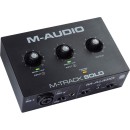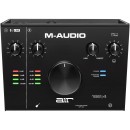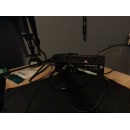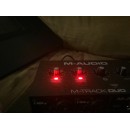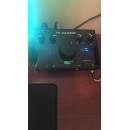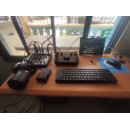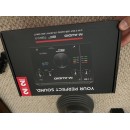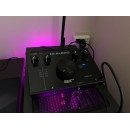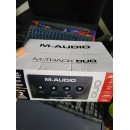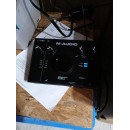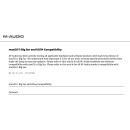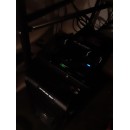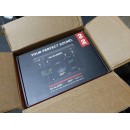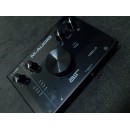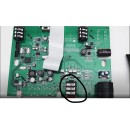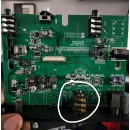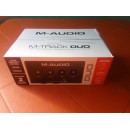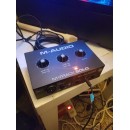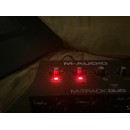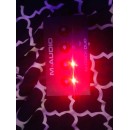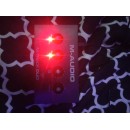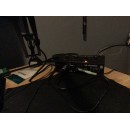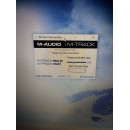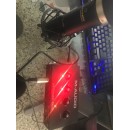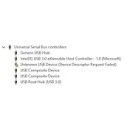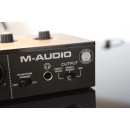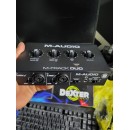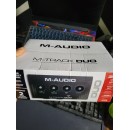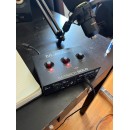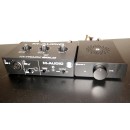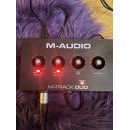M-Audio AIR 192|4 vs M-Audio M-Track Solo: Which Audio Interface is Right for You?
The M-Audio M-Track Solo is the more budget-friendly option of the two, offering a straightforward and easy-to-use interface. It features 2 channels: one XLR and one 1/4" TRS combo input, along with a 1/4" instrument input. The M-Track Solo supports 48 kHz audio resolution, which is adequate for standard recording needs. It also includes a useful direct monitoring feature, enabling zero-latency monitoring of the input signal. The interface connects to your computer via USB-A and is compatible with most DAWs. Its compact and portable design makes it an excellent choice for beginners or those needing a simple solution for basic recording tasks.
In contrast, the M-Audio AIR 192|4 is a step up in terms of capabilities and audio quality. This interface also provides 2x2 channels but boasts a superior 24-bit/192 kHz resolution, offering higher fidelity and more professional sound quality. The AIR 192|4 includes one XLR/TRS combo input and one 1/4" instrument input with Crystal preamps, which are designed to deliver ultra-clean, transparent sound. Additionally, this model features a USB Type-C connection, which allows for faster data transfer and lower latency. The inclusion of a VU LED meter adds a level of sophistication, allowing users to monitor input levels visually. The AIR 192|4 also comes bundled with a comprehensive software suite, including Pro Tools | First M-Audio Edition and Ableton Live Lite, making it a more versatile and complete package for those serious about their audio production.
In summary, the M-Audio M-Track Solo is ideal for beginners or those on a budget, offering essential features and adequate performance for basic recording needs. The M-Audio AIR 192|4, on the other hand, caters to more advanced users who require higher audio quality, better connectivity, and additional software tools to enhance their recording and production capabilities. Each interface has its own strengths, making them suitable for different types of users and applications.
Detailed Specifications and Pros & Cons of M-Audio AIR 192|4 and M-Audio M-Track Solo
| User Rating Based on Analysis of Reviews | |
|---|---|
|
Show More |
| Pros: | |
|---|---|
|
|
| Cons: | |
|---|---|
|
|
| Key Specs | |
|---|---|
| Channels of I/O | |
| Analog: 2 Inputs / 2 Outputs |
Analog: 2 Inputs / 2 Outputs at 192 kHz |
| Maximum Sampling Rate | |
| 48 kHz / 16-Bit | 192 kHz / 24-Bit |
| Number of Microphone Inputs | |
| 1 Preamp | 1 Preamp |
| Analog Audio I/O | |
| 1x Combo XLR-1/4" TRS Balanced Mic/Line Input (Front Panel) 1x 1/4" TRS Balanced/Unbalanced Line/Hi-Z Input (Front Panel) 1x Stereo RCA Coaxial Unbalanced Monitor Output 1x 1/8" / 3.5 mm TRS Unbalanced Headphone Output (Front Panel) |
1x Combo XLR-1/4" TRS Balanced Mic/Line Input 1x 1/4" TS Unbalanced Hi-Z Input (Front Panel) 2x 1/4" TRS Balanced Line Output 1x 1/4" TRS Unbalanced Headphone Output (Front Panel) |
| Host Connection | |
| 1x USB-B (Class-Compliant) | 1x USB-C (Class-Compliant) |
| OS Compatibility | |
| macOS 10.8 or Later Windows 7 or Later (32-/64-Bit) |
macOS 10.8 or Later Windows 7 or Later |
| Power Requirements | |
| USB Bus Power | USB Bus Power |
The M-Audio M-Track Solo offers two channels of analog I/O with a maximum sampling rate of 48 kHz at 16-bit resolution. It has one microphone input via a combo XLR-1/4" TRS balanced mic/line input and one 1/4" TRS balanced/unbalanced line/Hi-Z input. For outputs, it provides a stereo RCA coaxial unbalanced monitor output and a 1/8" (3.5 mm) TRS unbalanced headphone output. Connectivity is achieved through a USB-B port, and it is compatible with macOS 10.8 or later and Windows 7 or later, supporting both 32-bit and 64-bit systems. The device is powered via USB bus power.
On the other hand, the M-Audio AIR 192|4 delivers higher audio quality with a maximum sampling rate of 192 kHz at 24-bit resolution. Like the M-Track Solo, it features one microphone input via a combo XLR-1/4" TRS balanced mic/line input, but it enhances connectivity with a 1/4" TS unbalanced Hi-Z input on the front panel. Additionally, it offers two 1/4" TRS balanced line outputs and a 1/4" TRS unbalanced headphone output. The host connection is made through a USB-C port, ensuring faster data transfer and more robust connectivity. It is also compatible with macOS 10.8 or later and Windows 7 or later. The AIR 192|4 is USB bus-powered as well.
In summary, while both interfaces provide essential connectivity and USB bus power, the M-Audio AIR 192|4 stands out with its higher sampling rate, additional balanced line outputs, and USB-C connectivity, making it a more advanced choice for users seeking superior audio quality and greater flexibility. The M-Track Solo, however, remains a solid option for those needing a straightforward, reliable interface with basic features.
| General | |
|---|---|
| Channels of I/O | |
| Analog: 2 Inputs / 2 Outputs |
Analog: 2 Inputs / 2 Outputs at 192 kHz |
| Maximum Sampling Rate | |
| 48 kHz / 16-Bit | 192 kHz / 24-Bit |
| Number of Microphone Inputs | |
| 1 Preamp | 1 Preamp |
| Input Level Adjustment | |
| 2x Knob | 2x Knob |
| Expansion Slots | |
Both audio interfaces feature a single microphone preamp, allowing for the connection of one microphone. They also both have two input level adjustment knobs, providing control over the input signal levels. Neither interface includes built-in microphones or expansion slots, focusing solely on their core functionality as audio interfaces.
In summary, while both the M-Audio M-Track Solo and the AIR 192|4 provide similar I/O channel configurations and input adjustment options, the AIR 192|4 stands out with its superior audio resolution capabilities, supporting higher sampling rates and bit depths. This makes the AIR 192|4 a more suitable choice for users requiring higher audio quality in their recordings.
| Signal Processing | |
|---|---|
| Pad | |
| Gain/Trim Range | |
| Mic Inputs: 0 to +54 dB Line/Hi-Z Inputs: -10 to +44 dB |
Mic/Line Inputs: 55 dB Hi-Z Inputs: 24 dB |
| High-Pass Filter | |
| Solo/Mute | |
Starting with the M-Audio M-Track Solo, this interface does not feature a pad, high-pass filter, or solo/mute functions. It offers a gain/trim range of 0 to +54 dB for mic inputs and -10 to +44 dB for line/Hi-Z inputs. This range allows for a wide variety of input sources, making it a versatile option for users who need flexibility in gain control without advanced filtering or muting options.
On the other hand, the M-Audio AIR 192|4 also lacks a pad, high-pass filter, and solo/mute functionalities. However, it provides a gain/trim range of 55 dB for mic/line inputs and 24 dB for Hi-Z inputs. This slightly narrower gain range for Hi-Z inputs and a higher range for mic/line inputs suggests that the AIR 192|4 is tailored more towards users who require precision in mic/line input gain settings, possibly making it more suitable for professional recording environments.
In summary, while both interfaces share the absence of certain features like a pad, high-pass filter, and solo/mute options, they differ in their gain/trim range specifications. The M-Track Solo offers a broader range for both mic and Hi-Z inputs, whereas the AIR 192|4 provides a more refined gain/trim control for mic/line inputs, catering to different recording needs and preferences.
| Connectivity | |
|---|---|
| Analog Audio I/O | |
| 1x Combo XLR-1/4" TRS Balanced Mic/Line Input (Front Panel) 1x 1/4" TRS Balanced/Unbalanced Line/Hi-Z Input (Front Panel) 1x Stereo RCA Coaxial Unbalanced Monitor Output 1x 1/8" / 3.5 mm TRS Unbalanced Headphone Output (Front Panel) |
1x Combo XLR-1/4" TRS Balanced Mic/Line Input 1x 1/4" TS Unbalanced Hi-Z Input (Front Panel) 2x 1/4" TRS Balanced Line Output 1x 1/4" TRS Unbalanced Headphone Output (Front Panel) |
| Phantom Power | |
| 48 V, Selectable On/Off | 48 V, Selectable On/Off |
| Digital Audio I/O | |
| Host Connection | |
| 1x USB-B (Class-Compliant) | 1x USB-C (Class-Compliant) |
| Host Connection Protocol | |
| USB 2.0 | USB 2.0 |
| USB (Non-Host) | |
| Sync I/O | |
| Network I/O | |
| MIDI I/O | |
Starting with the analog audio I/O, the M-Track Solo offers 1x Combo XLR-1/4" TRS Balanced Mic/Line Input and 1x 1/4" TRS Balanced/Unbalanced Line/Hi-Z Input on the front panel. For output, it provides 1x Stereo RCA Coaxial Unbalanced Monitor Output and 1x 1/8" / 3.5 mm TRS Unbalanced Headphone Output. In comparison, the AIR 192|4 also features 1x Combo XLR-1/4" TRS Balanced Mic/Line Input and 1x 1/4" TS Unbalanced Hi-Z Input on the front panel but offers 2x 1/4" TRS Balanced Line Outputs and 1x 1/4" TRS Unbalanced Headphone Output. This means the AIR 192|4 provides balanced outputs which might be preferable for professional studio monitors.
Both interfaces have 48 V phantom power, which is selectable on/off, making them suitable for use with condenser microphones. However, they differ in their host connection type. The M-Track Solo uses a USB-B connection and adheres to the USB 2.0 protocol, while the AIR 192|4 uses a more modern USB-C connection, also supporting USB 2.0. This difference could affect compatibility and ease of connection with newer computer models.
Neither interface includes digital audio I/O, Sync I/O, Network I/O, or MIDI I/O, focusing solely on delivering high-quality analog inputs and outputs. The absence of these features indicates a streamlined design aimed at users who need essential audio recording capabilities without additional connectivity options.
In summary, the M-Track Solo is a more basic model suited for users who need a simple and straightforward audio interface with essential input and output options. On the other hand, the AIR 192|4 offers more professional features, such as balanced line outputs and a USB-C connection, making it a better choice for those who require higher-quality output and modern connectivity.
| Performance | |
|---|---|
| Frequency Response | |
| Mic, Line, Hi-Z Inputs: 20 Hz to 20 kHz ±0.1 dB Monitor Outputs: 20 Hz to 20 kHz ±0.1 dB Headphone Outputs: 20 Hz to 20 kHz ±0.5 dB |
Mic Inputs: 20 Hz to 20 kHz +0.1 dB Line, Hi-Z Inputs: 20 Hz to 20 kHz ±0.05 dB Monitor Outputs: 20 Hz to 20 kHz +0.06 dB |
| Maximum Output Level | |
| Line Outputs: +4 dBu |
Line Outputs: +7 dBu (Balanced, 1 kHz) |
| Impedance | |
| Hi-Z Inputs: 1 Megohm (Unbalanced) |
Hi-Z Inputs: 1 Megohm (Unbalanced) Headphone Outputs: 10 Ohms (Balanced) |
| SNR | |
| Mic Inputs: 109 dB (A-Weighted) Monitor Outputs: 109 dB (A-Weighted) Headphone Outputs: 100 dB (A-Weighted) |
Mic Inputs: 104 dB (A-Weighted) Line Inputs: 101 dB (A-Weighted) Hi-Z Inputs: 102 dB (A-Weighted) Monitor Outputs: 102 dB (A-Weighted) |
| THD+N | |
| Mic Inputs: 0.003% (A-Weighted, Min Gain, at 0 dBu) Line Inputs: 0.002% (A-Weighted, Min Gain, at 0 dBu) Hi-Z Inputs: 0.005% (A-Weighted, Min Gain, at 0 dBu) Monitor Outputs: 0.002% (A-Weighted, at 0 dBu) Headphone Outputs: 0.02% (A-Weighted) |
Mic/Line Inputs: 0.003% Hi-Z Inputs: 0.004% Headphone/Monitor Outputs: 0.005% |
| EIN | |
| Mic Inputs: -128 dBu A-Weighted (Max Gain) |
Mic Inputs: -128 dBu A-Weighted (150-Ohm Source, Max Gain) |
In terms of frequency response, the M-Track Solo offers a range of 20 Hz to 20 kHz with a variance of ±0.1 dB for mic, line, and Hi-Z inputs, as well as monitor outputs. The headphone outputs have a slightly broader variance of ±0.5 dB. The AIR 192|4 delivers a similar frequency response for mic inputs (+0.1 dB) and line, Hi-Z inputs (±0.05 dB), and a slightly different monitor output at +0.06 dB.
When looking at maximum output levels, the M-Track Solo provides a line output level of +4 dBu and a headphone output power of 60 mW per channel into 32 Ohms. The AIR 192|4 has a higher line output level at +7 dBu (balanced, 1 kHz), and its headphone output impedance is listed at 10 Ohms (balanced), although its output power is not specified.
The impedance for Hi-Z inputs on both interfaces is identical at 1 Megohm (unbalanced). However, the AIR 192|4 specifies an additional impedance for headphone outputs at 10 Ohms (balanced).
In terms of signal-to-noise ratio (SNR), the M-Track Solo offers 109 dB (A-weighted) for mic and monitor outputs, and 100 dB (A-weighted) for headphone outputs. The AIR 192|4 presents a slightly lower SNR with 104 dB (A-weighted) for mic inputs, 101 dB for line inputs, 102 dB for Hi-Z and monitor outputs.
Total harmonic distortion plus noise (THD+N) for the M-Track Solo is impressively low at 0.003% for mic inputs, 0.002% for line inputs, 0.005% for Hi-Z inputs, 0.002% for monitor outputs, and 0.02% for headphone outputs. The AIR 192|4 has similar THD+N values with mic/line inputs at 0.003%, Hi-Z inputs at 0.004%, and headphone/monitor outputs at 0.005%.
Lastly, both interfaces have identical equivalent input noise (EIN) for mic inputs at -128 dBu A-weighted. However, the AIR 192|4 specifies this with a 150-Ohm source at max gain, whereas the M-Track Solo does not specify the source impedance.
Overall, while both interfaces offer strong performance, the AIR 192|4 edges out with slightly higher dynamic range and output levels, making it potentially more suitable for users requiring higher fidelity and output power. The M-Track Solo, however, provides competitive specifications, particularly in terms of its low THD+N and high SNR, making it a very solid choice for most recording needs.
| Digital Audio | |
|---|---|
| Sample Rates | |
| 48 kHz (AD/DA Conversion) | Up to 192 kHz (AD/DA Conversion) |
| Sample Rate Conversion | |
| Bit Depths | |
| 16-Bit (AD/DA Conversion) | 24-Bit (AD/DA Conversion) |
| Latency | |
| Zero-Latency Direct Monitoring | 2.59 ms (Dependent on Buffer Size, Input to Output) |
| Sync Sources | |
| Internal | Internal |
The M-Audio M-Track Solo offers a sample rate of 48 kHz for AD/DA conversion, which is suitable for basic recording and playback needs. In contrast, the M-Audio AIR 192|4 supports much higher sample rates of up to 192 kHz, making it a better choice for high-fidelity audio recording and playback. Additionally, the M-Track Solo operates at a bit depth of 16-bit for AD/DA conversion, which is standard for most entry-level interfaces. On the other hand, the AIR 192|4 provides 24-bit depth, offering more dynamic range and detail in the recorded audio.
Latency is another important factor where these two interfaces differ. The M-Track Solo boasts zero-latency direct monitoring, ensuring that there is no delay between the input and output during recording. The AIR 192|4, while not zero-latency, offers a very low latency of 2.59 ms, which can vary depending on the buffer size. This low latency is still quite suitable for most recording purposes and is unlikely to be a significant issue for most users.
Both interfaces use internal sync sources, ensuring stable and reliable timing for digital audio processes. However, considering the overall specifications, the AIR 192|4 is a more advanced and capable audio interface compared to the M-Track Solo, offering higher sample rates, greater bit depth, and very low latency, making it ideal for more professional recording scenarios.
| Audio Storage & Playback | |
|---|---|
| Memory Card Slot | |
Despite this shared characteristic, there may be other differences between the two audio interfaces in terms of connectivity, audio quality, and additional features that could influence a user's choice. However, when considering the specific aspect of memory card slots, both the M-Track Solo and the AIR 192|4 are identical in not providing this feature.
| Compatibility | |
|---|---|
| OS Compatibility | |
| macOS 10.8 or Later Windows 7 or Later (32-/64-Bit) |
macOS 10.8 or Later Windows 7 or Later |
| Required Hardware | |
| Available USB-A Port USB Cable (Included) |
Available USB 2.0 Port or USB-C Port USB Cable (Included) |
| Internet Connection | |
| Required for Registration, Software/Driver Download | Required for Registration, Software/Driver Download |
In terms of OS compatibility, both devices support macOS 10.8 or later and Windows 7 or later, ensuring a wide range of users can utilize these interfaces regardless of their operating system preference.
For required hardware, the M-Track Solo necessitates an available USB-A port, along with the included USB cable. On the other hand, the AIR 192|4 offers more flexibility by supporting either a USB 2.0 port or a USB-C port, again with the necessary USB cable included in the package.
Both interfaces require an internet connection for registration and software or driver downloads, ensuring users can quickly get started and maintain updated software for optimal performance.
However, a notable distinction is the mobile device compatibility. The AIR 192|4 explicitly states no compatibility with mobile devices, whereas the M-Track Solo does not specify this parameter, suggesting it may have limited or undefined mobile device support.
| Power | |
|---|---|
| Power Requirements | |
| USB Bus Power | USB Bus Power |
The M-Audio M-Track Solo connects through a standard USB interface, ensuring compatibility with a wide range of computers and devices. On the other hand, the M-Audio AIR 192|4 utilizes a USB Type-C connection, which offers faster data transfer rates and improved performance when compared to traditional USB interfaces. This makes the AIR 192|4 potentially more suitable for setups requiring low latency and high-speed data transfer.
In summary, while both the M-Audio M-Track Solo and the M-Audio AIR 192|4 are powered via USB bus power, the key difference lies in their connectivity. The M-Track Solo uses a standard USB connection, whereas the AIR 192|4 employs a USB Type-C connection for enhanced performance.
| Physical | |
|---|---|
| Dimensions | |
| 6.4 x 4.5 x 2.1" / 16.3 x 11.4 x 5.3 cm | 8 x 6 x 2.76" / 20.3 x 15.2 x 7.01 cm |
| Weight | |
| 0.7 lb / 0.3 kg | 2.0 lb / 0.9 kg |
The M-Audio M-Track Solo is more compact and lightweight, measuring 6.4 x 4.5 x 2.1 inches (16.3 x 11.4 x 5.3 cm) and weighing just 0.7 lb (0.3 kg). This makes it a highly portable option, suitable for users who need to move their audio interface frequently or those with limited desk space.
In contrast, the M-Audio AIR 192|4 is larger and heavier, with dimensions of 8 x 6 x 2.76 inches (20.3 x 15.2 x 7.01 cm) and a weight of 2.0 lb (0.9 kg). While it may occupy more space and be less convenient to transport, its heft can contribute to a more stable setup on a desktop.
Moreover, the M-Audio AIR 192|4 includes an additional security feature: a Kensington Security Slot. This anti-theft feature offers an extra layer of protection, which can be particularly useful in studio environments where security is a concern.
Overall, the M-Track Solo is ideal for users prioritizing portability and compactness, while the AIR 192|4 offers more robust physical security and may be better suited for a stationary studio setup.
| Packaging Info | |
|---|---|
| Package Weight | |
| 1.155 lb | 2.85 lb |
| Box Dimensions (LxWxH) | |
| 8 x 6 x 3.7" | 11 x 7.5 x 4.8" |
The M-Audio M-Track Solo has a package weight of 1.155 lb and its box dimensions measure 8 x 6 x 3.7 inches. This makes it a more lightweight and compact option, which could be beneficial for users who need a portable audio interface that is easy to transport and requires less storage space.
In contrast, the M-Audio AIR 192|4 has a package weight of 2.85 lb, nearly two and a half times heavier than the M-Track Solo. The box dimensions for the AIR 192|4 are 11 x 7.5 x 4.8 inches, indicating that it is also larger in size. The increased weight and dimensions might be attributed to more robust build quality or additional features, which could appeal to users looking for a more durable and potentially feature-rich audio interface.
In summary, the M-Audio M-Track Solo is the lighter and more compact option, while the M-Audio AIR 192|4 is heavier and larger, suggesting differences in their build and possibly the range of features they offer.
| Customer Images | |
|---|---|
| Videos | |
|---|---|
|
|
|
